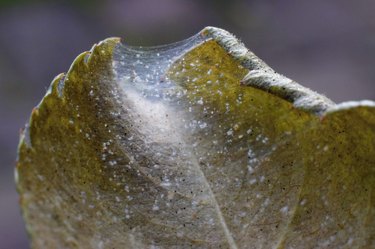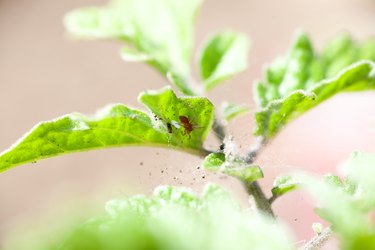
Spider mites are common garden pests throughout the United States, frequently in gardens and landscaping. Although they are different colors, spider mites are 1/50th inch long so difficult to see with the naked eye. Most of them are red or brown, but others are pale, and they often gather in large numbers and make webs on plants. Aside from the webs, which are tell-tale signs of spider mites, gardeners also find spider mite damage on plants. These bugs suck fluids from plant leaves, leaving light dots where they damaged the foliar tissues.
Cause of Spider Mites
Video of the Day
The reason spider mites infest a plant is because of a lack of natural spider mite predators. In outdoor gardens and greenhouses, insecticide use causes the death of those beneficial insects. Gardeners may use a pesticide to get rid of a pest such as flea beetles, but that pesticide also kills beneficial insects, including ladybugs, which would otherwise take care of the spider mite population.
Video of the Day
No spider mite predators are usually inside homes, and dust that accumulates on plant leaves attracts spider mites. Plants in hot, dry spaces are also prone to spider mites.
Spider Mite Predators

- Spider mite destroyer lady beetle -- The United States is home to more than a half dozen different species of this beneficial insect. Both the larvae and adults of the tiny black beetle feed on spider mites. Each of these highly specialized predators subsists solely upon spider mites and can consume up to of the critters daily.
- Lady bug -- The adult lady bug is a big eater, consuming up to 100 spider mites per day. Adults and larvae prey upon spider mites, as well as aphids, whiteflies, leaf beetle larvae, some insect eggs, scale insects and even small caterpillars.
- Spined soldier bugs -- This beneficial insect is a member of the stink bug family preys on spider mites as well as other garden pests, including cabbage loopers, flea beetles and Colorado potato beetles.
- Lacewing larva -- In its short lifespan of two to three weeks, one lacewing larva can consume up to 11,200 spider mites. Often called "aphid lions," these generalists do indeed eat aphids, but also prey upon a large array of soft-bodied bugs including mealybugs, mites, whiteflies and insect eggs.
Plants for Attracting Beneficial Bugs

Although beneficial insects consume spider mites in a garden, they also use flower nectar as a food source. So adding certain flowering plant varieties to a garden will lure beneficial insects to the food source, and they will stay to feast on spider mites and other pests.
Yarrow (Achillea spp.) attracts beneficial insects to its clusters of tiny blooms from summer to fall. Yarrow is a perennial in U.S. Department of Agriculture plant hardiness zones 3 through 9.
Coreopsis plants (Coreopsis spp.) also lure beneficial insects, including ladybugs. Lanceleaf coreopsis (Coreopsis lanceolata) features small, yellow blooms from May to July. Perennial in USDA zones 4 through 9, this plant is particularly useful in dry and rocky soil.
Dill (Anethum spp.) is an annual plant that is usually grown for its feathery leaves used in cooking. When it is in bloom, dill has clusters of tiny, yellow flowers that attract beneficial insects, including predators, bees and butterflies.